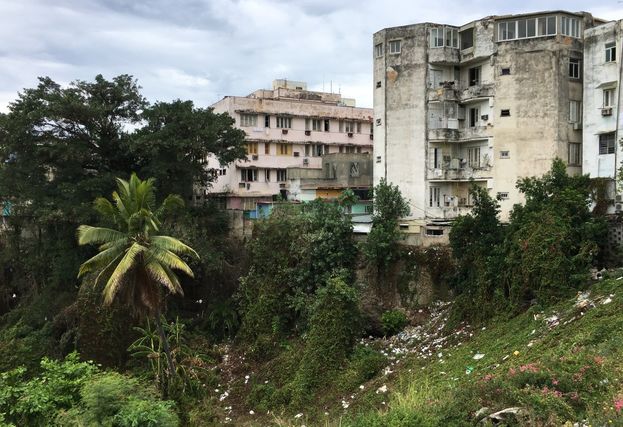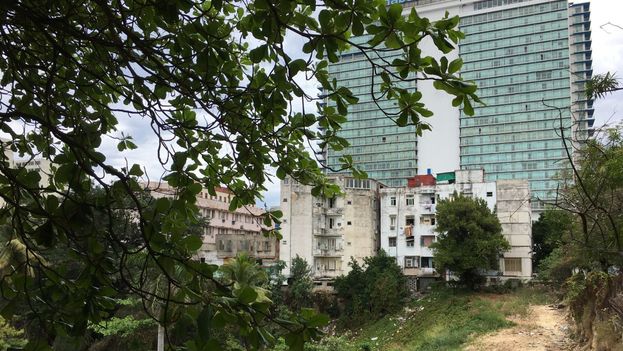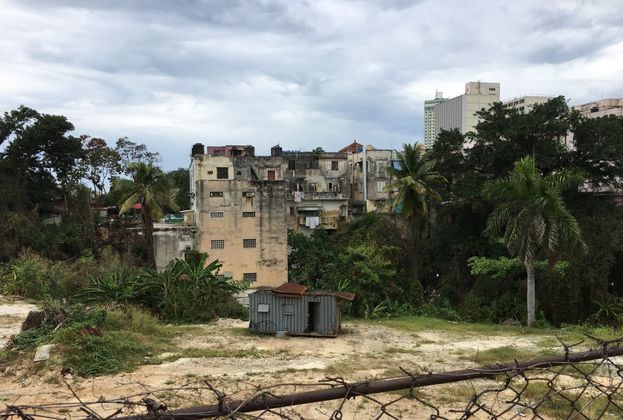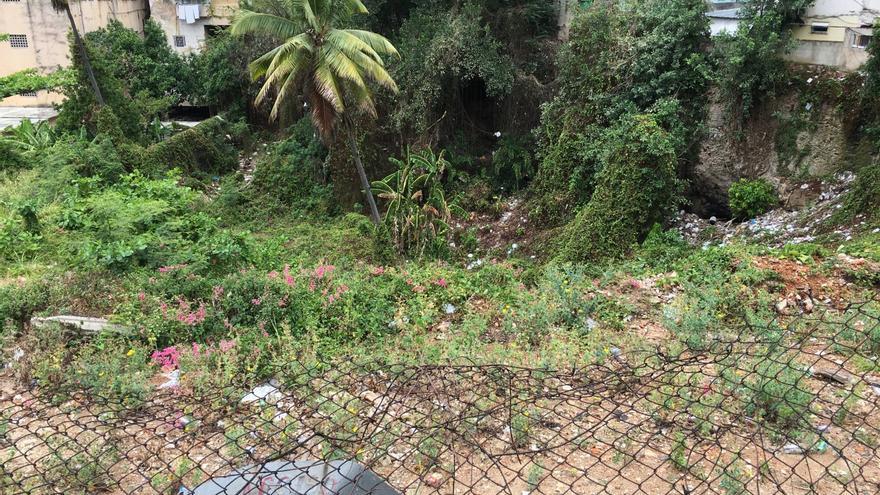![]() Marcelo Hernandez, Havana | 30 April 2018 – Though little known despite being located in the heart of Vedado, the empty lot at 25th and K streets in Havana has become a major topic of conversation. The official press recently announced that the tallest hotel in Havana — a mass of concrete that worries some while delighting others — will be built on this impressive but overgrown, inaccessible pocket of land.
Marcelo Hernandez, Havana | 30 April 2018 – Though little known despite being located in the heart of Vedado, the empty lot at 25th and K streets in Havana has become a major topic of conversation. The official press recently announced that the tallest hotel in Havana — a mass of concrete that worries some while delighting others — will be built on this impressive but overgrown, inaccessible pocket of land.
Ramón has spent almost two decades parking cars a few yards from the spot where Empresa Inmobiliaria Almest, a real estate business owned by the Cuban armed forces, plans to erect a 42-story, 565-room tower. People around here have a lot of questions,” he says, reminiscing how as a child he played in “that abyss down there.”
A garbage dump and home to street cats, the site has remained almost empty even though population growth in the capital — now a city of over two million inhabitants — has caused every centimeter of space around it to be filled in. The abandonment of the site “has been its good fortune and its downfall,” says Ramón, who does not approve of the project.
From the hubbub of 23rd Street, the lot — surrounded by trees — can barely be detected by people waiting at the always crowded bus stop on what is one of Havana’s main arteries.
’I had hoped they would turn this into a pretty little park, with stairs and a recreation area, because this part of the city doesn’t have anything like that. But this vertical turd is the last thing we need,” says Ramón. “I didn’t like how it looked in the picture I saw. It’s horrendous.”

Photos of the model, published in government media outlets, show a building designed in a quintessentially Manhattan style. Marked by a dark and sober façade, “the monster,” as some area residents have already dubbed it, will have a ground floor dedicated to services and a pool from which guests can enjoy a view of Havana.
The new structure will stand in stark contrast to other buildings in the area, such as the Hotel Nacional and the award-winning Focsa Building, with their balconies, wide terraces, pastel colors and views of the sea lapping at the shoreline of the city’s most dynamic neighborhood.
Construction is scheduled to be completed in 2022. The building will be taller than the Habana Libre hotel and the towering monument at the Plaza of the Revolution, currently the tallest structure in the capital. However, neither its location or its planned five-star rating seem to have convinced its nearest neighbors or the architects.
“The architectural model looks like a shoebox,” says Amanda Corrales ironically. The young architecture graduate, who together with some friends runs a small private remodeling practice, adds, “The era of the skyscraper is over but we always arrive late to the party. So now we are opting for that type of vertical construction that disrupts all harmony.”

Havana has not seen much vertical growth, more because of economic crisis than because of conscious decisions on the part of authorities. We have been saved from a very common phenomenon in Latin American capitals: an abundance of tall buildings. Once we reach that point here, there is no need to worry about making aesthetic mistakes of that size.”
A building of that size is a small city and everything has to work with clock-like precision. It will be very susceptible to any number of problems, such as water cutoffs, electrical blackouts and hurricanes,” she points out. “Maintaining something like that is going to be very expensive and there is some question as to whether the growth in tourism will be enough to make a building of that magnitude profitable.”
The young professional is upset because “there so many good architects in this country but no publication has reported who is in charge of the hotel project.” Corrales believes that “a construction project of this importance, given its prominent location, should have been awarded through a competition so that the best design could have been chosen.”
However, like the powerful military conglomerate’s other projects, the lot on 25th Street is shrouded in secrecy. The names of the building’s architects have not been released but, within the profession’s trade union, there are doubts they are Cuban. “Didn’t they bring in workers from India to finish the Hotel Manzana Kempinski?” asks Corrales. “Would anyone be surprised if the architects aren’t from here either?”

Some, however, are more enthusiastic. One of them is Yosvel, a young man who works at a nearby private restaurant and spends hours outside hawking its menu. “A hotel of that size can help us attract customers. Many of its guests will ultimately want to try the food of local restaurants,” he says.
“It will bring new life to the area. People are already thinking about working here because obviously there will be a need for a lot of employees ,” he speculates. Yosvel himself, however, is not interested: “A lot of work for not much money. It will be a five-star hotel but salaries will be poverty level.” He also believes that “tourism has to rebound so that it has adequate occupancy.”
“This is not Dubai but, at the same time, we do not have to resign ourselves to remaining a city frozen in time. Foreigners would like that but those of us who live here need some visual modernity, more daring construction and buildings that will make us feel proud,” says Yosvel.
In the first four months of this year the number of tourists visiting Cuba shrank by 7% compared to the same period in 2016. In spite of these figures, the authorities announced that they expect two million visitors by the end of May and five million by the end of 2018.

But renewed tensions between Washington and Havana has reduced the flow of visitors from the United States, the island’s most promising and geographically accessible market. “Things are hard and, if they build a hotel with so many rooms nearby, they will get worse,” says consider Georgina (a.k.a Yoyi), owner of a house, whose four bedrooms she rents out, barely more than fifty yards from the site.
“It isn’t a fair competition because, if the government builds a hotel that big, it could leave a lot of rentors in the area without any income,” she predicts. She believes, however, that “private businesses can always offer more personalized and family-style service. And many tourists won’t want to be stuck in that big box,” she says ironically.
The area’s business owners can already feel Havana’s tallest hotel casting its long shadows over them. Though many of them, like Yoyi, are confident that “it will never be built because there are neither the materials nor expertise to build something like that here.”
They haven’t started pouring the foundations of the building that will mark the highest point in the city’s profile and controversy surrounds its construction. As with almost any issue of Cuba’s current reality, there are no nuances when people evaluate the new building. “It’s horrible,” declares Yoyi. But to Matiza Yosvel, “It’s the beginning of Havana’s future.”
____________________
The 14ymedio team is committed to serious journalism that reflects the reality of deep Cuba. Thank you for joining us on this long road. We invite you to continue supporting us, but this time by becoming a member of 14ymedio. Together we can continue to transform journalism in Cuba.
